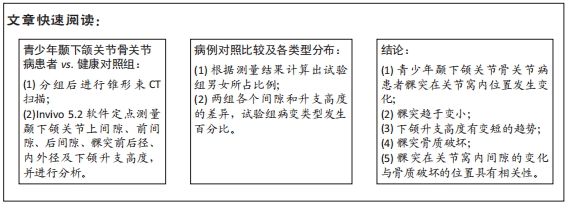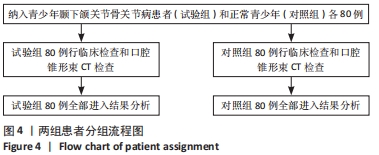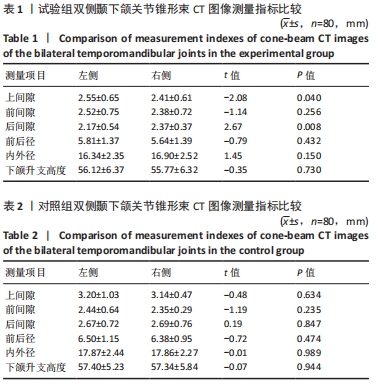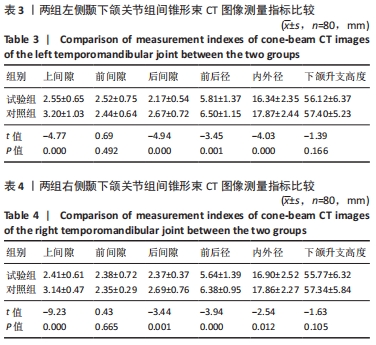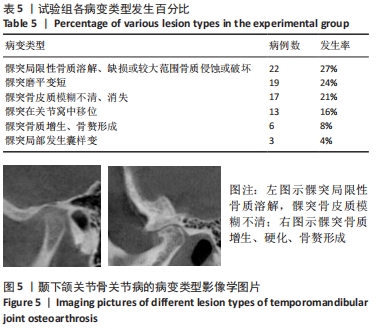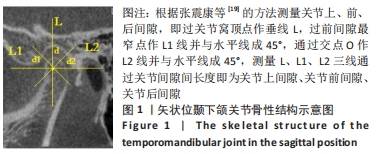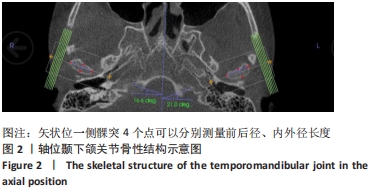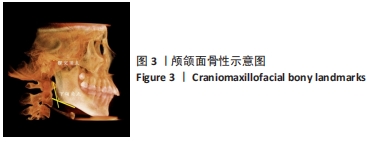[1] 毛伟玉,刘木清,傅开元.颞下颌关节弥漫型腱鞘巨细胞瘤的 CT 影像特征[J].华西口腔医学杂志,2018,36(3):282.
[2] 李欣,唐静,李泽奎,等.锥形束 CT 重建评价髁突骨性增龄性变化[J]. 中国组织工程研究,2017,21(19):3044-3050.
[3] BERNHARDT O, BIFFAR R, KOCHER T, et al. Prevalence and clinical signs of degenerative temporomandibular joint changes validated by magnetic resonance imaging in a non-patient group. Ann Anat. 2007;189(4):342-346.
[4] 王玉良,杨驰,杨佑成.髁突特异性吸收的研究进展[J].滨州医学院学报,2008,31(2):124-125.
[5] WOLFORD LM, CARDENAS L. Idiopathic condylar resorption: diagnosis, treatment protocol,and outcomes. Am J Orthod Dentofacial Orthop. 1999;116(6):667-677.
[6] 雷杰,刘木清,傅开元.睡眠问题,焦虑及压力是颞下颌关节紊乱病肌筋膜疼痛发病的风险指标[J].北京大学学报(医学版),2016, 48(4):692-696.
[7] 吕曜光,邵博,贾梦莹,等.单侧颞下颌关节滑膜炎关节间隙变化的影像学研究[J].口腔医学研究,2018,34(3):245-248.
[8] 胡欣欣,朱耀旻,何柳婷,等.109 例颞下颌关节紊乱病相关因素分析[J].上海口腔医学,2017,26(2):213-216.
[9] ARNETT GW, GUNSON MJ. Risk factors in the initiation of condylar resorption//Seminars in Orthodontics. WB Saunders, 2013;19(2):81-88.
[10] WOLFORD LM. Idiopathic condylar resorption of the temporomandibular joint in teenage girls (cheerleaders syndrome). Proc (Bayl Univ Med Cent). 2001;14(3):246-252.
[11] 刘岩,张曦,王美青,等.颞下颌关节紊乱病的三维咬合评价系统开发[J].中国医学装备,2020,17(4):5-8.
[12] 顾非,庄月琴,王峻良,等.影像学移动度测量在颞下颌关节紊乱病诊断中的应用[J].中国医药导报,2016,13(31):113-115,127.
[13] 许跃,林秋平,林韩,等.锥形束CT颞下颌关节上腔造影在诊断关节盘病变中的应用[J].中华口腔医学研究杂志(电子版),2016,10(5): 347-351.
[14] 秦思思,雷杰,傅开元.锥形束CT评估颞下颌关节重度骨关节病患者正颌术后髁突骨质再吸收[J].现代口腔医学杂志,2016,30(5):261-265.
[15] HONDA K, LARHEIM TA, MARUHASHI K, et al. Osseous abnormalities of the mandibular condyle:diagnostic reliability of cone beam computed tomography compared with helical computed tomography based on an autopsy material. Dentomaxillofac Radiol. 2006;35(3):152-157.
[16] 孟娟红,张万林,柳登高,等.牙颌面锥形束CT与普通X线检查对颞下颌关节骨关节病诊断价值的比较研究[J].北京大学学报(医学版),2007,38(1):26-29.
[17] 傅开元,张万林,柳登高,等.应用锥形束CT诊断颞下颌关节骨关节病的探讨[J].中华口腔医学杂志,2007,42(7):417-420.
[18] 莫晓春. 关于“青少年”年龄界定问题的思考[J]. 广西青年干部学院报,2009,19(2):38-40.
[19] 张震康,赵福运,孙广熙,等.正常成年人颞颌关节 100侧X线分析[J].中华医学杂志,1975,55(3):130-132 .
[20] NEVILLE BW, DAMM DD, ALLEN CM, et al. Oral and maxillo-facial pathology. 2nd ed. Philadelphia: Saunders, 2002:755.
[21] KATAKAMI K, SHIMODA S, KOBAYASHI K, et al. Histological investigation of osseous changes of mandibular condyleswith backscattered electron images. Dentomaxillofac Radiol. 2008;37(6):330-339.
[22] 钟洪涛.螺旋CT、锥形束CT与MRI在颞下颌关节紊乱病成像中的应用比较[J].影像研究与医学应用,2017,1(9):126-127.
[23] 吴燕燕,俞焕苗,李帅,等.全景片与锥形束CT对诊断AngleⅡ~ 2错牙合畸形颞下颌关节改变的研究[J].口腔医学,2016,36(2):158-161.
[24] 詹伊宁,胡颖恺,马志贵,等.青少年关节镜下盘复位术后颞下颌关节间隙及髁突位置的改变[J].中国口腔颌面外科,2020,18(1):33-37.
[25] 许晓岑,房莉,曾飞煌,等.口腔正畸中3种常用头影测量技术的对比研究[J]. 口腔医学研究,2014,30(4):348-351.
[26] XI T, VAN LOON B, FUDALEJ P, et al. Validation of a novelsemi-automated method for three-dimensional surface rendering of condyles using conebeam computed tomography data. Int Joral Maxillofac Surg. 2013;42(8):1023-1029.
[27] ROH HS, KIM W, KIM YK, et al. Relationships between disk displacement, joint effusion, and degenerative changes of the TMJ in TMD patients based on MRI finding. J Craniomaxillofac Surg. 2012;40(3):283-286.
[28] MONCADA G, CORTÉS D, MILLAS P, et al. Relationship between disk position and degenerative bone changes in temporomandibular joints of young subjects with TMD. an MRI study. J Clin Pediatr Dent. 2014; 38(3):269-276.
[29] 曹均凯,王照五,刘洪臣,等.54例正常人双侧TMJ CBCT测量值分析[J].口腔颌面修复学杂志,2008,9(4):291-294.
[30] 李晶.TMJ 紊乱综合征与牙合创伤症的调磨临床研究[J].中国现代药物应用,2013,7(4):26-27.
[31] 韩帮锋,罗倩婷,张颖,等.528例儿童颞下颌关节紊乱病的回顾性研究[J].口腔颌面修复学杂志,2021,22(1):33-37.
[32] 李晓敏,杨晓喻,陈奕帆,等.TMJ骨关节病不同分期的锥形束CT三维位置比较[J].华西口腔医学杂志,2015,33(2):161-165.
|
